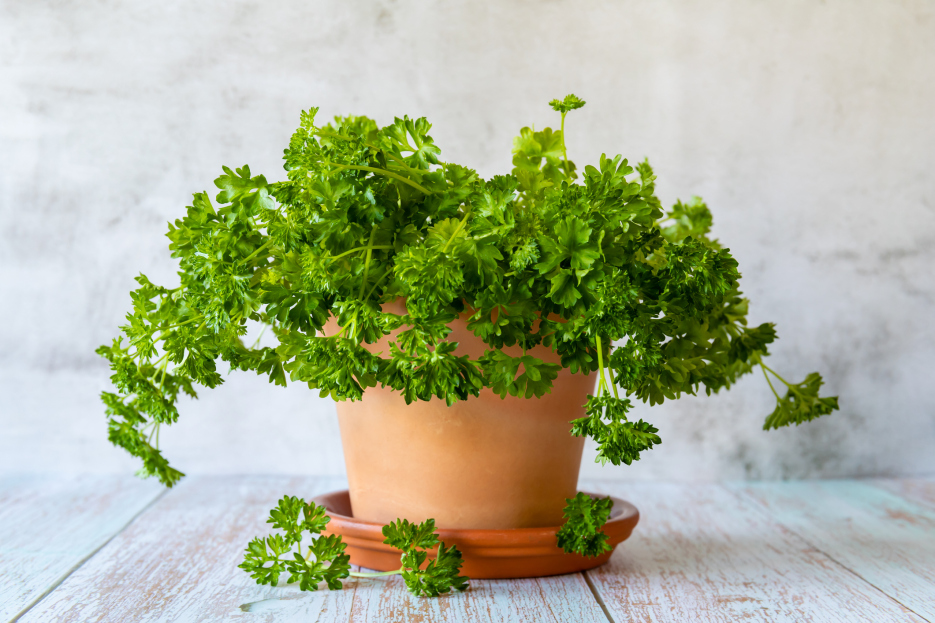
Parsley is a flavorful and versatile herb, perfect for cooking and garnishing, and packed with nutrients like vitamin C. While it’s easy to grow, giving it proper care will keep it lush and vibrant all season. Here’s your guide to growing parsley at home!
Parsley grows best in full sunlight but can tolerate partial shade, making it adaptable to both indoor and outdoor environments. Ideally, they should get 6 hours of direct sunlight per day. If you’re growing them indoors, place it near a sunny windowsill. For outdoor gardens, ensure it's in a location that gets morning sun and afternoon shade, especially in hotter climates.
Parsley benefits from light feeding throughout its growing season. Use an organic, balanced fertilizer every 4-6 weeks to support healthy leaf growth. If you’re growing them in pots, you may need to fertilize a bit more frequently since nutrients leach out of containers more quickly. Be careful not to over-fertilize, as this can cause the plant to grow too quickly and lose some flavor.
Parsley prefers consistently moist soil, but make sure it’s not waterlogged. Water the plant when the top inch of soil feels dry. Deep watering every few days is better than frequent light watering. Outdoor plants generally need more water than indoor plants, especially during hot weather. Container-grown plants should be checked more frequently as pots can dry out faster. If watering into a pot without drainage holes, be sure to discard any excess water after watering.
Parsley thrives in well-draining soil that is rich in organic matter. A mix of regular potting soil with compost works well. Ensure your container has drainage holes to prevent water from pooling at the roots. They do not need frequent re-potting but can be re-potted once every season if grown in containers. When re-potting, choose a pot that’s at least 8-10 inches deep to accommodate its long taproot.
Parsley is a cool-season herb, thriving in temperatures between 50°F and 70°F (10°C to 21°C). It can tolerate some light frost but does not perform well in extreme heat. If you’re growing them outdoors in hot climates, provide afternoon shade to prevent wilting and stress. They can thrive year-round as long as it's kept in a cool environment away from heating vents.
Parsley does well in moderate humidity levels. Indoor gardeners may want to mist the plant occasionally during dry winter months to keep the leaves lush. However, avoid excessive humidity, as this can encourage fungal issues. Outdoor plants generally receive adequate humidity from natural weather patterns.
Parsley is most commonly grown from seeds. Soak the seeds in water overnight before planting to speed up germination, which can take 2-4 weeks. You can also divide an existing plant in the spring or fall and replant the divisions in fresh soil. Since they has a long taproot, be careful when transplanting to avoid damaging the roots.
Regular pruning encourages bushier growth and keeps the plant producing fresh leaves. Harvest parsley by cutting the outer stems at the base of the plant, leaving the inner stems to continue growing. Avoid cutting more than one-third of the plant at a time. Also, remove any yellowing or wilted leaves to maintain overall health.
Parsley is relatively pest-resistant but can be affected by aphids, spider mites, or caterpillars, such as the parsley worm (black swallowtail caterpillar). Check the plant regularly, and if pests appear, spray with an organic insecticidal soap or neem oil. Fungal diseases like leaf spot and root rot can occur if the plant is overwatered or in poor-draining soil.
Yes, parsley is safe for both cats and dogs when consumed in small amounts. However, large quantities may cause digestive issues, particularly in pets with sensitive stomachs. It’s always a good idea to keep herbs out of reach from pets to avoid overconsumption.
Parsley prefers full sun but can tolerate partial shade, requiring about 6 hours of direct light per day.
Water when the top inch of soil feels dry. In hot weather, this may be every few days for outdoor plants.
Parsley grows well in rich, well-draining soil, ideally amended with compost.
Yes, parsley can be grown indoors near a sunny window or under a grow light.
Parsley is usually grown from seeds, but you can also divide a mature plant and transplant the divisions.
Parsley thrives in cool temperatures between 50°F and 70°F (10°C to 21°C).
Regularly trim outer stems at the base, leaving the inner stems to continue growing. Avoid cutting more than one-third of the plant at once.
Parsley can attract aphids, spider mites, and parsley worms. Regularly inspect the plant for pests and treat with organic sprays if needed.
Yes, parsley benefits from balanced, organic fertilizer every 4-6 weeks during the growing season.